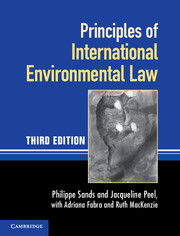Book contents
- Frontmatter
- Contents
- Foreword
- Preface and acknowledgments to the first edition
- Preface and acknowledgments to the second edition
- Preface and acknowledgments to the third edition
- Table of cases
- Table of treaties and other international instruments
- Abbreviations
- Part I The legal and institutional framework
- Part II Principles and rules establishing standards
- 6 General principles and rules
- 7 Atmospheric protection and climate change
- 8 Freshwater resources
- 9 Oceans, seas and marine living resources
- 10 Biological diversity
- 11 Hazardous substances and activities
- 12 Waste
- 13 The polar regions: Antarctica and the Arctic
- Part III Techniques for implementing international principles and rules
- Part IV Linkage of international environmental law and other areas of international law
- Index
- References
11 - Hazardous substances and activities
from Part II - Principles and rules establishing standards
Published online by Cambridge University Press: 05 June 2012
- Frontmatter
- Contents
- Foreword
- Preface and acknowledgments to the first edition
- Preface and acknowledgments to the second edition
- Preface and acknowledgments to the third edition
- Table of cases
- Table of treaties and other international instruments
- Abbreviations
- Part I The legal and institutional framework
- Part II Principles and rules establishing standards
- 6 General principles and rules
- 7 Atmospheric protection and climate change
- 8 Freshwater resources
- 9 Oceans, seas and marine living resources
- 10 Biological diversity
- 11 Hazardous substances and activities
- 12 Waste
- 13 The polar regions: Antarctica and the Arctic
- Part III Techniques for implementing international principles and rules
- Part IV Linkage of international environmental law and other areas of international law
- Index
- References
Summary
INTRODUCTION
International environmental law has tended to regulate specific environmental media and/or resources rather than particular activities or products. There is, however, now a significant body of rules which regulate those activities or products considered by the international community, within a region or globally, to be hazardous or dangerous and to merit specific attention. The Biosafety Protocol, regulating certain categories of genetically modified organisms produced via processes of biotechnology, is one such example considered in the previous chapter. The reason for international attention to these substances and activities lies in their potential for global or transboundary impacts on human health or the environment. For instance, toxic chemicals such as dioxins persist in the environment over long timeframes and can be dispersed through air or water over a large area. Equally, activities such as the generation of nuclear energy warrant international regulatory involvement when poor safety practices or accidents result in widespread radioactive contamination.
As will be seen, hazardous substances and activities are not presently regulated by any single international organisation or treaty that establishes principles and rules of general application to all such substances or activities. The international community has instead adopted broad policy guidelines. Principle 6 of the 1972 Stockholm Declaration declared that the ‘discharge of toxic substances or of other substances and the release of heat, in such quantities or concentrations as to exceed the capacity of the environment to render them harmless, must be halted in order to ensure that serious or irreversible damage is not inflicted upon ecosystems’. According to Principle 14 of the Rio Declaration, ‘states should effectively co-operate to discourage or prevent the relocation and transfer to other states of any activities and substances that cause severe environmental degradation or are found to be harmful to human health’. Rules developed after the 1972 Stockholm Conference arise from a range of international acts of differing legal qualities, with competence devolved to different international organisations. This has contributed to a certain lack of coherence, and to reactive and fragmented rules which may be difficult to identify or interpret. The result is a patchwork of international regulations the applicability of which depends upon the nature and characteristics of a particular substance and the location where it is being manufactured or used.
- Type
- Chapter
- Information
- Principles of International Environmental Law , pp. 514 - 553Publisher: Cambridge University PressPrint publication year: 2012

